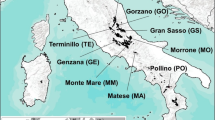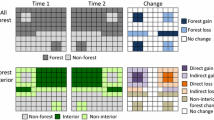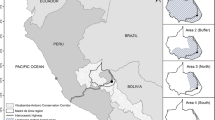Abstract
Kibale National Park, within the Albertine Rift, is known for its rich biodiversity. High human population density and agricultural conversion in the surrounding landscape have created enormous resource pressure on forest fragments outside the park. Kibale presents a complex protected forest landscape comprising intact forest inside the park, logged areas inside the park, a game corridor with degraded forest, and forest fragments in the landscape surrounding the park. To explore the effect of these different levels of forest management and protection over time, we assessed forest change over the previous three decades, using both discrete and continuous data analyses of satellite imagery. Park boundaries have remained fairly intact and forest cover has been maintained or increased inside the park, while there has been a high level of deforestation in the landscape surrounding the park. While absolute changes in land cover are important changes in vegetation productivity, within land cover classes are often more telling of longer term changes and future directions of change. The park has lower Normalized Difference Vegetation Index (NDVI) values than the forest fragments outside the park and the formerly logged area—probably due to forest regeneration and early succession stage. The corridor region has lower productivity, which is surprising given this is also a newer regrowth region and so should be similar to the logged and forest fragments. Overall, concern can be raised for the future trajectory of this park. Although forest cover has been maintained, forest health may be an issue, which for future management, climate change, biodiversity, and increased human pressure may signify troubling signs.





Similar content being viewed by others
References
Brooks T, Balmford A, Burgess N, Fjeldsa J, Hansen LA, Moore J, Rahbek C, Williams P (2001) Toward a blueprint for conservation in Africa. Bioscience 51:613–624
Chapman CA, Chapman LJ, Zanne A, Burgess M (2002) Does weeding promote regeneration of an indigenous tree community in felled pine plantations in Uganda? Restor Ecol 10:408–415
Chapman CA, Chapman LJ, Ghai RR, Hartter J, Jacob AL, Lwanga JS, Omeja PA, Rothman JM, Twinomugisha D (2010a) In: Plumptre AJ (ed) Complex responses to climate and anthropogenic changes: an evaluation based on data from Kibale National Park, Uganda. Nova Science Publishers, Hauppauge, pp 70–87
Chapman CA, Chapman LJ, Jacob AL, Rothman JM, Omeja P, Reyna-Hurtado R, Hartter J, Lawes MJ (2010b) Tropical tree community shifts: implications for wildlife conservation. Biol Conserv 143(2):366–374
Clark DB (1996) Abolishing virginity. J Trop Ecol 12:735–739
Cordeiro NJ, Burgess ND, Dovie DBK, Kaplin BA, Plumptre AJ, Marrs R (2007) Conservation in areas of high population density in sub-Saharan Africa. Biol Cons 134(2):155–163
DeFries R, Hansen A, Newton AC, Hansen MC (2005) Increasing isolation of protected areas in tropical forests over the past twenty years. Ecol Appl 15(1):19–26
Duncan BW, Boyle S, Breininger DR, Schmalzer PA (1999) Coupling past management practice and historic landscape change on John F Kennedy Space Center, Florida. Landscape Ecol 14:291–309
Ehrlich D, Estes JE, Singh A (1994) Applications of NOAA-AVHRR 1 km data for environmental monitoring. Int J of Remote Sens 15(1):145–161
Foody GM, Curran PJ (1994) Estimation of tropical forest extent and regenerative stage using remotely-sensed data. J Biogeogr 21:223–244
Geist HJ, Lambin EF (2002) Proximate causes and underlying driving forces of tropical deforestation. Bioscience 52(2):143–150
Goldman A, Hartter J, Southworth J, Binford M (2008) The human landscape around the island park: impacts and responses to Kibale National Park. In: Wrangham R, Ross E (eds) Science and conservation in African forests: the benefits of longterm research. Cambridge University Press, Cambridge, pp 129–144
Hartter J (2009) Attitudes of rural communities towards wetlands and forest fragments around Kibale National Park, Uganda. Hum Dimens Wildl 14(6):433–447
Hartter J (2010) Resource use and ecosystem services in a forest park landscape. Soc Natl Res 23(3):207–233
Hartter J, Goldman AC (2011) Local responses to a forest park in western Uganda: alternative narratives on fortress conservation. Oryx 45(1):60–68
Hartter J, Southworth J (2009) Dwindling resources and fragmentation of landscapes around parks: wetlands and forest fragments around Kibale National Park, Uganda. Landscape Ecol 24(5):643–656
Hartter J, Southworth J, Binford M (2009) Parks as a mechanism to maintain and facilitate recovery of forest cover: examining reforestation, forest maintenance and productivity in Uganda. In: Southworth J, Nagendra H (eds) Reforesting landscapes: linking pattern and process. Springer Landscape Series, New York, pp 275–296
Jacob AL, Vaccaro I, Sengupta R, Hartter J, Chapman CA (2008) How can conservation biology best prepare for declining rural population and ecological homogenization? Trop Conserv Sci 4:307–320
Jensen JR, Lin H, Yang X, Ramsey EW III, Davis BA, Thoemke CW (1991) The measurement of mangrove characteristics in southwest Florida using SPOT multispectral data. Geocarto Intl 2:13–21
Knapp S, Kühn I, Schweiger O, Klotz S (2008) Challenging urban species diversity: contrasting phylogenetic patterns across plant functional groups in Germany. Ecol Lett 11(10):1054–1064
Laporte NT, Walker W, Stabach JA, Landsberg F (2008) Monitoring forest-savanna dynamics in Kibale National Park with satellite imagery (1989–2003): implications for the management of wildlife habitat. In: Wrangham R, Ross E (eds) Science and conservation in African forests: how long-term research promotes habitat protection. Cambridge University Press, New York, pp 38–50
Lawes MJ, Chapman CA (2006) Does the herb Acanthus pubescens and/or elephants suppress tree regeneration in disturbed Afrotropical forests? For Ecol Manag 221:274–284
Lepp A, Holland S (2006) A comparison of attitudes toward state-led conservation and community-based conservation in the village of Bigodi, Uganda. Soc Natl Res 19:609–623
National Environment Management Authority (2001) State of environment report for Uganda 2000/2001. National Environment Management Authority, Kampala
Naughton-Treves L (1998) Predicting patterns of crop damage by wildlife around Kibale National Park, Uganda. Conserv Biol 12:156–168
Naughton-Treves L, Treves A, Chapman C, Wrangham R (1998) Temporal patterns of crop-raiding by primates: linking food availability in croplands and adjacent forest. J Appl Ecol 35:596–606
Naughton-Treves L, Alix-Garcia J, Chapman CA (in press) Parks and poverty: lessons from a decade of forest loss and economic growth around Kibale National Park, Uganda. PNAS
Omeja PA, Chapman CA, Obua J, Lwanga JS, Jacob AL, Wanyama F, Mugenyi R (2011) Intensive tree planting facilitates tropical forest biodiversity and biomass accumulation. For Ecol Manag 261:703–709
Parks SA, Harcourt AH (2002) Reserve size local human density and mammalian extinctions in US protected areas. Conserv Biol 16:800–808
Petorelli N, Ryan SJ, Mueller T, Bunnefeld N, Jedrzejewska B, Lima M, Kausrud K (2011) The Normalized Difference Vegetation Index (NDVI) in ecology: a decade of unforseen successes. Clim Res 46:15–27
Pettorelli N, Vik JO, Mysterud A, Gaillard JM, Tucker CJ, Stenseth NC (2005) Using the satellite-derived NDVI to assess ecological responses to environmental change. Trends Ecol Evol 20:503–510
Plumptre AJ (2002) Extent and status of the forests in the Ugandan Albertine Rift. Unpublished Report to UNDP/GEF. Wildlife Conservation Society, Kampala
Plumptre AJM, Behangana M, Davenport TRB, Kahindo C, Kityo R, Ndomba E, Nkuutu D, Owiunji I, Ssegawa P, Eilu G (2003) The biodiversity of the Albertine Rift. Albertine Rift Technical Reports. Wildlife Conservation Society, Kampala
Plumptre AJ, Davenport TRB, Behangana M, Kityo R, Eilu G, Ssegawa P, Ewango C, Meirte D, Kahindo C, Herremans M, Kerbis Peterhans J, Pilgrim JD, Wilson M, Languy M, Moyer D (2007) The biodiversity of the Albertine Rift. Biol Conserv 134(2):178–194
Rey-Benayas JM, Pope KO (1995) Landscape ecology and diversity patterns in the seasonal tropics from Landsat TM imagery. Ecol Appl 5:386–394
Roughgarden J, Running SW, Matson PA (1991) What does remote sensing do for ecology? Ecology 72(6):1918–1922
Ryan SJ, Knechtel CU, Getz WM (2007) Ecological cues, gestation length, and birth timing in African buffalo. Behav Ecol 18:635–644
Schonewald-Cox CM, Bayless JW (1986) The boundary model: a geographic analysis of design and conservation of nature reserves. Biol Conserv 38:305–322
Serneels S, Said MY, Lambin EF (2001) Land cover changes around a major East African wildlife reserve: the Mara ecosystem (Kenya). Int J Remote Sens 22(17):3397–3420
Southworth J, Munroe D, Nagendra H (2004) Land cover change and landscape fragmentation—Comparing the utility of continuous and discrete analyses for a western Honduras region. Agric Ecosyst Environ 101:185–205
Southworth J, Hartter J, Binford MW, Goldman AC, Chapman CA, Chapman LJ, Omeja P, Binford E (2010) Landscape effects of an East African national park on the protected tropical forest and its surrounding area. Trop Conserv Sci 3(2):122–142
Steven MD, Malthus TJ, Baret F, Xu H, Chopping M (2003) Intercalibration of vegetation indices from different sensor systems. Remote Sens Environ 88:412–422
Struhsaker TT (1997) Ecology of an African rain forest: logging in Kibale and the conflict between conservation and exploitation. The University Press of Florida, Gainesville
Struhsaker TT (2002) Strategies for conserving forest national parks in Africa with a case study from Uganda. In: Terborgh J, Van Schaik C, Davenport L, Rao M (eds) Making parks work: strategies for preserving tropical nature. Island Press, Washington, pp 97–111
van Bommel FPJ, Heitkönig IMA, Epema GF, Ringrose S, Bonyongo C, Veenendaal EM (2006) Remotely sensed habitat indicators for predicting distribution of impala (Aepyceros melampus) in the Okavango Delta, Botswana. J Trop Ecol 22:101–110
Willems EP, Barton RA, Hill RA (2009) Remotely sensed productivity, regional home range selection, and local range use by an omnivorous primate. Behav Ecol 20(5):985–992
Woods CH, Skole D (1998) Linking satellite, census, and survey data to study deforestation in the Brazilian Amazon. In: Liverman D, Moran EF, Rindfuss RR, Stern PC (eds) People and pixels: linking remote sensing and social science. National Academy Press, Washington, pp 70–93
Acknowledgments
This research was supported by the National Science Foundation grant (#0352008). S.J. Ryan conducted this work while a Postdoctoral Associate at the National Center for Ecological Analysis and Synthesis, a Center funded by NSF (Grant #EF-0553768), the University of California, Santa Barbara, and the State of California. Funding for C. Chapman was provided by Canada Research Chairs Program, National Geographic Society, and a NSERC grant. The imagery used in this analysis was purchased in part through NSF (SBR-9521918) as part of the ongoing research at the Center for the Study of Institutions, Population, and Environmental Change (CIPEC) at Indiana University. Permission to conduct this research was granted by Uganda National Council for Science and Technology and Uganda Wildlife Authority. We are grateful to Agaba Erimosi, Mwesigwe Peace, Kisembo Benjamin, and Byaruhanga Joseph for excellent assistance in the field; and Liz Binford and Barbara Cook for processing images.
Author information
Authors and Affiliations
Corresponding authors
Rights and permissions
About this article
Cite this article
Hartter, J., Ryan, S.J., Southworth, J. et al. Landscapes as continuous entities: forest disturbance and recovery in the Albertine Rift landscape. Landscape Ecol 26, 877–890 (2011). https://doi.org/10.1007/s10980-011-9616-0
Received:
Accepted:
Published:
Issue Date:
DOI: https://doi.org/10.1007/s10980-011-9616-0




